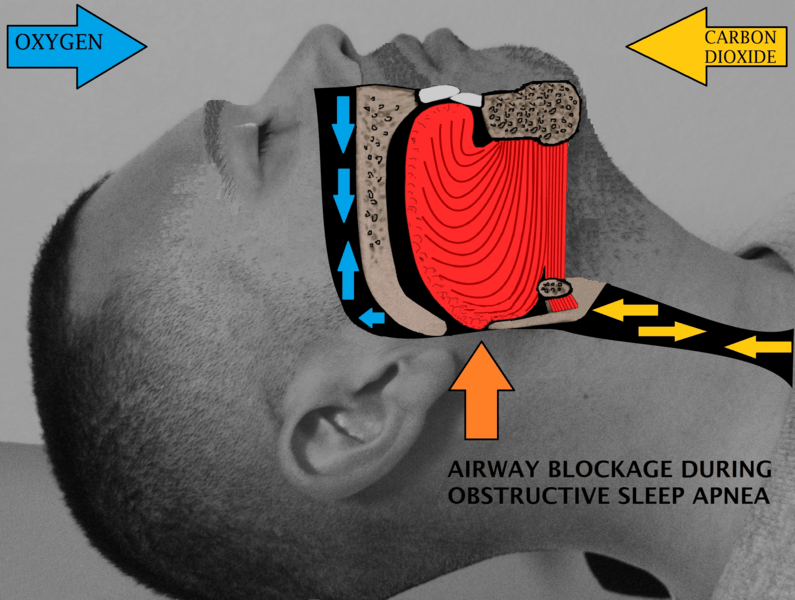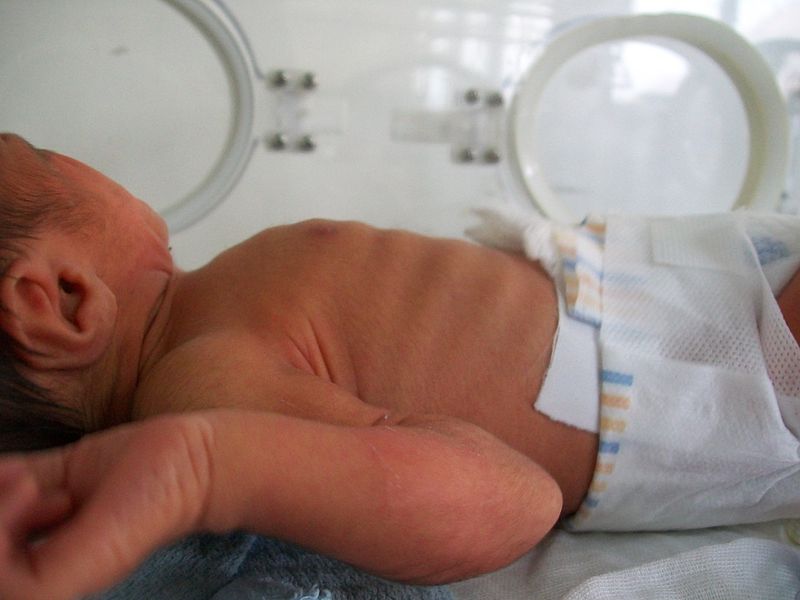Difference Between Apnea and Dyspnea
Key Difference – Apnea vs Dyspnea
Apnea and dyspnea are two conditions that affect the normal pattern and mechanism of respiration. Apnea is the cessation of breathing that lasts for 10 seconds or more during sleeping. Dyspnea, on the other hand, is the feeling of an uncomfortable need to breathe. The key difference between apnea and dyspnea is that in sleep apnea, the process of breathing is completely stopped whereas, in dyspnea, breathing process is not entirely obstructed but only partially interrupted.
CONTENTS
1. Overview and Key Difference
2. What is Apnea
3. What is Dyspnea
4. Similarities Between Apnea and Dyspnea
5. Side by Side Comparison – Apnea vs Dyspnea in Tabular Form
6. Summary
What is Apnea?
Apnea is the cessation of breathing that lasts for 10 seconds or more during sleeping. But if the number of episodes per a cycle of sleep is less than five, it is not considered as pathological.
Main three types of apnea have been described
Obstructive Sleep Apnea
Because of different causes, the upper airway can collapse, impeding the flow of air through it. Apnea due to any obstruction of the nose, pharynx or larynx also falls under this category.
Pathophysiology of OSA
Apnea compromises the supply of oxygen to the body tissues and leads to the retention of carbon dioxide. As a consequence of this gaseous imbalance, the pulmonary vasculature is constricted, causing pulmonary hypertension. This, in turn, can give rise to cardiac hypoxia, congestive cardiac failure, and cardiac arrhythmias.
Consequences of OSA
- Sleep fragmentation and day time sleepiness
- Congestive heart failure and cor pulmonale
- Cardiac arrhythmias
- Polycythemia and hypertension
- Snoring spouse syndrome
- Loss of memory
- Decreased libido
Risk Factors
- Male gender
- Age above 40 years
- Obesity

Figure 01: Apnea
Management
Clinical Evaluation
In taking the history, it is important to have the presence of the patient’s bed partner because the information given by the patient is not authentic most of the time. During clinical examination, emphasis should be on the basic areas mentioned below.
- BMI
- Collar size
- Complete head and neck examination
- Muller’s maneuver
- Systemic examination should be carried out to look for hypertension and signs of any other systemic illness
- Cephalometric radiographs – the purpose of them is to exclude the possibility of any craniofacial anomalies and obstruction at the base of the tongue.
- Polysomnography
This is the gold standard investigation for the diagnosis of sleep apnea.The following records and measurements are taken during polysomnography;
EEG, ECG, Electroculogram, Electro myography, pulse oximetry, nasal and oral airflow, blood pressure, esophageal pressure and sleep position.
Treatment
Non surgical
- Lifestyle modifications such as the reduction of body weight, adherence to a balanced and healthy diet, and minimizing the consumption of alcohol.
- Positional therapy
- Intraoral devices
- Continuous positive airway pressure
Surgical
- Tonsillectomy and/or adenoidectomy
- Nasal surgery
- Oropharyngeal surgery
- Advancement genioplasty with hyoid suspension
- Tongue base frequency radiography
- Maxillomandibular advancement osteotomy
What is Dyspnea?
Dyspnea is defined as the feeling of an uncomfortable need to breathe. According to the duration, it can be categorized into two categories as
- Acute Severe Breathlessness
- Chronic Exertional Breathlessness
Chronic Exertional Breathlessness
Dyspnea of long duration is called the chronic exertional breathlessness. Features of this condition differ depending on the underlying pathology. Therefore, several important questions should be asked during the history taking.
In COPD, the breathlessness is minimum at rest but it is exacerbated by exercise. In asthmatics, dyspnea worsens at night resulting in sleep disturbances which the patient promptly complains of. There will be orthopnea if the patient is having a cardiac failure.
Progressive loss of exercise capacity is a feature of COPD. In asthma, a unique variability of the exercise capacity is seen. On the other hand, if the patient is dyspneic even at rest, then the patient is more likely to be suffering from interstitial fibrosis.
Any allergen capable of eliciting an anaphylactic reaction should be identified.
Causes
Acute Severe Breathlessness
This is a medical emergency.
During the history, taking questions should be asked about the,
- Rate of onset of breathlessness
- Severity
- Presence of associated symptoms such as chest pain
In pediatric patients, always consider the possibility of acute epiglottitis and a foreign body obstructing the airway.
Important features that should be assessed during the clinical assessment are,
- Level of consciousness
- Degree of central cyanosis
- Signs of anaphylaxis such as urticaria
- Patency of the upper airway
- Ability to speak
- Cardiovascular status

Figure 02: Sternal retractions which are a sign of dyspnea
What is the Similarity Between Apnea and Dyspnea?
- In both conditions, the mechanism of respiration is interrupted.
What is the Difference Between Apnea and Dyspnea?
Apnea vs Dyspnea | |
| Apnea is the cessation of breathing that lasts for 10 seconds or more during sleeping. | Dyspnea is defined as the feeling of an uncomfortable need to breathe. |
| Interruptions | |
| The mechanism of breathing is completely interrupted. | There is only a partial interruption to the mechanism of breathing. |
| Time | |
| This only occurs during sleep. | This can occur during any time. |
Summary – Apnea vs Dyspnea
Apnea and dyspnea are two conditions that affect the normal pattern and mechanism of respiration. The key difference between apnea and dyspnea is that in sleep apnea, the process of breathing is completely stopped whereas, in dyspnea, breathing process is not entirely obstructed but only partially interrupted. Although both these conditions can be treated quite conveniently with a high rate of success, not getting proper treatments can have serious and sometimes even fatal consequences.
Download PDF Version of Apnea vs Dyspnea
You can download PDF version of this article and use it for offline purposes as per citation notes. Please download PDF version here Difference Between Apnea and Dyspnea.
References:
1. Kumar, Parveen J., and Michael L. Clark. Kumar & Clark clinical medicine. Edinburgh: W.B. Saunders, 2009. Print.
2. Dhingra, P. L. Diseases of ear, nose and throat. New Delhi, Elsevier, 2010.
Image Courtesy:
1. “Airway obstruction” By Drcamachoent – Own work (CC BY-SA 4.0) via Commons Wikimedia
2. “Sternal retractions” By Bobjgalindo – Own work (GFDL) via Commons Wikimedia
ncG1vNJzZmivp6x7pbXFn5yrnZ6YsqOx07CcnqZemLyue8OinZ%2Bdopq7pLGMm5ytr5Wau26tz6ecmmWRo7FuwtJmm7KroKOyons%3D